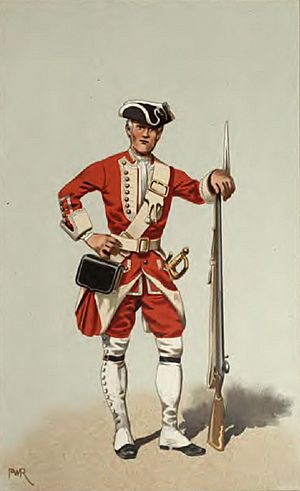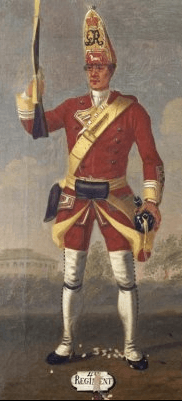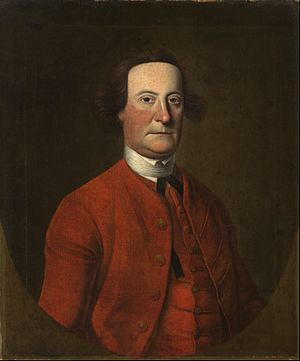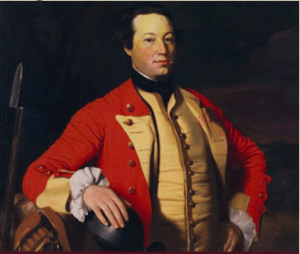40th (the 2nd Somersetshire) Regiment of Foot facts for kids
Quick facts for kids 40th (the 2nd Somersetshire) Regiment of Foot |
|
|---|---|
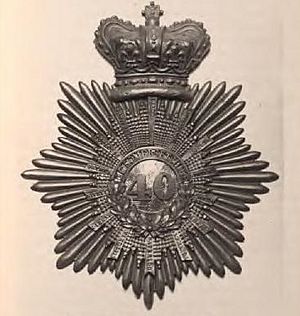
Officer's Cap Badge 40th (the 2nd Somersetshire) Regiment of Foot c.1830
|
|
| Active | 1717–1881 |
| Country | |
| Branch | |
| Type | Line Infantry |
| Role | Light Infantry |
| Size | One battalion (2 battalions 1799-1802, 1804-1816) |
| Garrison/HQ | Peninsula Barracks, Warrington |
| Nickname(s) | "The Excellers", "The Fighting Fortieth" |
| Colors | Light Buff Facings, Gold Braided Lace |
| Engagements | Father Rale's War King George's War Father Le Loutre's War French and Indian War American Revolutionary War Napoleonic Wars War of 1812 First Anglo-Afghan War Gwalior Campaign New Zealand Wars |
The 40th Regiment of Foot was a famous group of soldiers in the British Army. They were formed in 1717 in Annapolis Royal, Nova Scotia. These soldiers were known as 'infantry,' meaning they fought on foot. The regiment was also called "The Excellers" or "The Fighting Fortieth." In 1881, it joined with another regiment to become the Prince of Wales's Volunteers (South Lancashire Regiment).
Contents
- The Regiment's Story
- How the Regiment Started
- Early Battles: Father Rale's War
- King George's War: Facing New Challenges
- Father Le Loutre's War: Protecting New Settlements
- French and Indian War: Major Conflicts
- American Revolution: Fighting for the Crown
- Napoleonic Wars: European Conflicts
- The Victorian Era: Global Service
- Uniforms
- Battle Honors
- Regiment Leaders
- See also
The Regiment's Story
How the Regiment Started
The 40th Regiment was created in August 1717. It was first called the Richard Philipps's Regiment of Foot. General Richard Philipps formed it in Annapolis Royal, Nova Scotia. He brought together smaller groups of soldiers already in North America and the West Indies.
Early Battles: Father Rale's War
Before a conflict known as Father Rale's War, the Mi'kmaq people attacked a British fishing village in Canso in 1720. Governor Philipps sent soldiers from the 40th Regiment to protect the area. These soldiers helped stop attacks on ships in 1723.
In July 1724, about 60 Mi'kmaq warriors attacked Annapolis Royal. The soldiers tried to fight them off but lost some men. The Mi'kmaq took some people prisoner before leaving. For many years, from 1717 to 1743, the regiment helped protect settlers. They also kept French influence in the area in check. This helped Britain keep its hold on Atlantic Canada.
King George's War: Facing New Challenges
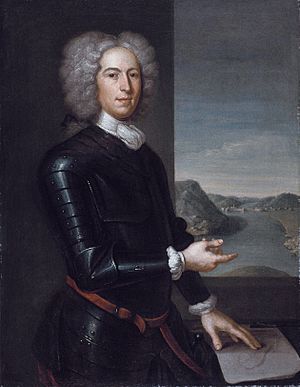
When King George's War began in 1744, French forces attacked Canso. About 900 French soldiers and local fighters surrounded the 40th Regiment's companies. The British soldiers, who didn't have enough supplies, had to surrender. Canso was destroyed, and the soldiers were taken prisoner.
After being released, the soldiers went to Boston. They gave important information about the French fort at Louisbourg. This information helped the British plan their attack the next year.
In July 1744, 300 Indigenous fighters led by a French priest attacked Annapolis Royal. Only 80 soldiers from the 40th Regiment were there to defend it. Their commander, Lieutenant Colonel Paul Mascarene, refused to give up. The attackers burned some houses but then left.
After this, King George II allowed the regiment to get more soldiers. They needed 450 men, but it was hard to find new recruits. Even so, the regiment kept defending Britain's land in Nova Scotia.
The 40th Regiment also helped as marines on ships. A group of soldiers from Newfoundland volunteered to serve on a captured French ship. They fought bravely in Fishotte Bay, capturing several French ships. This showed their courage on both land and sea.
By the end of the war, the regiment had defended Nova Scotia with few soldiers. More men were then sent from England to join them. It was also allowed to recruit soldiers from the American colonies, which was unusual for a British regiment.
Father Le Loutre's War: Protecting New Settlements
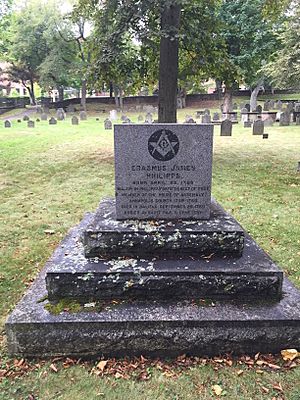
The 40th Regiment was also involved in Father Le Loutre's War. In 1749, some soldiers from the regiment went to protect the new settlement of Halifax. Mi'kmaq warriors surprised them, capturing some soldiers. These prisoners were later returned.
The soldiers also worked to keep roads safe between Halifax and Annapolis Royal. They helped set up new forts like Fort Sackville and Fort Edward.
By 1750, Edward Cornwallis became the new leader of the regiment. He worked hard to make the regiment stronger. He made sure soldiers followed rules and punished those who left without permission. In 1751, the regiment officially became the 40th Regiment of Foot.
Major Charles Lawrence joined the 40th Regiment and became a strong leader. He led an attack in 1750 that defeated a larger group of Indigenous fighters. He also built Fort Lawrence, which was important for defending the area.
French and Indian War: Major Conflicts
In 1755, the British decided to remove the French fort at Beausejour. Soldiers from the 40th Regiment helped in this attack. They quickly defeated French and local fighters. Fort Beausejour surrendered after only four days.
The 40th Regiment was also involved in the Expulsion of the Acadians from Annapolis Royal. This was a difficult task, as some officers had family ties to the Acadian people. The commander, Major John Handfield, even had to deport his own wife's relatives. He wrote that it was a "most disagreeable and troublesome part of the Service."
After 40 years in Annapolis Royal, the regiment moved to Halifax in 1757. In 1758, they helped in the second Siege of Louisbourg. The next year, they took part in a successful attack on Montréal, which ended the war in that area.
The regiment then moved to the Caribbean, fighting in the Battle of Havana in 1762. In 1763, they returned to Annapolis Royal. Then, for the first time in 48 years, the regiment served in Ireland, on British soil.
American Revolution: Fighting for the Crown
The 40th Regiment arrived in Boston in June 1775 to fight in the American Revolutionary War. They were moved from Boston to Halifax in 1776. They fought in many important battles, including the Battle of Long Island in August 1776 and the Battle of Princeton in January 1777.
They also saw action at the Battle of Brandywine in September 1777 and the Battle of Germantown in October 1777. In 1778, they went to the Caribbean again and fought in the Battle of St. Lucia.
The regiment returned to America in 1781 and fought in the Battle of Groton Heights. Their commander, Major William Montgomery, was killed in this attack. In 1782, the regiment was given a county name: the 40th (the 2nd Somersetshire) Regiment of Foot. They returned home to England in 1783.
Napoleonic Wars: European Conflicts
In 1794, the regiment went to the Caribbean for the French Revolutionary Wars. They helped capture Martinique and attack Guadeloupe. Some soldiers were captured and held as prisoners of war. The rest of the regiment returned to England.
They also fought in the West Indies again in 1795. Then, they took part in a campaign in Holland in 1799, fighting in the Battle of Bergen and the Battle of Alkmaar.
The regiment also served in the Mediterranean, fighting in Egypt in 1801. They were part of an attack on Montevideo in South America in 1807.
In 1808, the regiment went to Portugal to join Sir Arthur Wellesley's army in the Peninsular War. They fought in many famous battles, including the Battle of Roliça and the Battle of Vimeiro in 1808. They also fought at the Battle of Talavera in 1809.
The 40th Regiment was involved in the Siege of Ciudad Rodrigo and the Siege of Badajoz in 1812. They also fought bravely at the Battle of Salamanca and the Battle of Vitoria in 1813. They chased the French army into France, fighting at the Battle of the Pyrenees and the Battle of Toulouse.
In 1814, the regiment was sent to New Orleans for the War of 1812. However, the war ended before they saw much action.
Just before the Battle of Waterloo in May 1815, the regiment quickly joined Wellington's army. They were placed in the center of the battle line and held their ground all day. They helped stop Napoleon's final attack. The regiment lost 170 men killed or wounded, including their commanding officer. They stayed in France for a while before returning to England in 1817.
The Victorian Era: Global Service
In 1823, the regiment was sent to Australia in small groups on convict ships. They served in Sydney and Van Diemen's Land (now Tasmania). They were involved in the Black War there.
Later, they moved to India, serving in Belgaum and Pune. In 1839, they helped capture Karachi. The regiment then went to Afghanistan, where many soldiers became sick. They fought bravely at the Battle of Kabul in 1842 during the First Anglo-Afghan War.
The regiment returned to India in 1842 and fought in the Gwalior Campaign at the Battle of Maharajpore in 1843. They returned to England in 1845.
In 1852, the regiment went back to Australia. They helped stop the Eureka Rebellion in 1854. They also fought in the New Zealand Wars in the early 1860s. The regiment returned home in 1866 and then went back to India in 1872.
In 1881, the 40th Regiment officially joined with the 82nd Regiment of Foot. Together, they formed the Prince of Wales's Volunteers (South Lancashire Regiment). This marked the end of the 40th Regiment as a separate unit.
Uniforms
Battle Honors
The 40th Regiment earned many honors for its bravery in battle. These honors include:
- Egypt
- Montevideo
- Roliça
- Vimiero
- Talavera
- Badajoz
- Salamanca
- Vittoria
- Pyrenees
- Nivelle
- Orthes
- Peninsula
- Toulouse
- Waterloo
- Candahar (1842)
- Ghuznee (1842)
- Cabool (1842)
- Maharajpore
- New Zealand
Regiment Leaders
Here are some of the important leaders, called Colonels, of the regiment:
- 1717–1750: Lt-Gen. Richard Philipps
- 1750–1752: Lt-Gen. Hon. Edward Cornwallis
- 1752–1759: Maj-Gen. Peregrine Thomas Hopson
- 1759–1760: Maj-Gen. Hon. John Barrington
- 1760–1770: Lt-Gen. Robert Armiger
- 1770–1786: Lt-Gen. Sir Robert Hamilton, 4th Baronet of Silvertonhill
- 1786–1818: Gen. Sir George Osborn, 4th Baronet
- 1818–1829: Gen. Sir Brent Spencer, GCB
- 1829–1834: Gen. Sir James Kempt, GCB, GCH
- 1834–1837: Lt-Gen. Sir George Cooke, KCB
- 1837–1842: Lt-Gen. Sir Lionel Smith, 1st Baronet, GCB, GCH
- 1842–1861: F.M. Sir Alexander George Woodford, GCB, GCMG
- 1861–1872: Gen. Richard Greaves
- 1872–1881: Gen. Augustus Halifax Ferryman, CB
See also
 In Spanish: Regimiento n.º 40 de Infantería para niños
In Spanish: Regimiento n.º 40 de Infantería para niños



